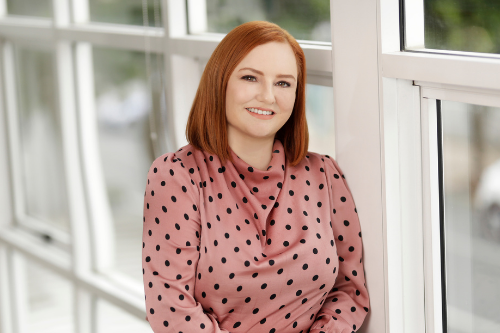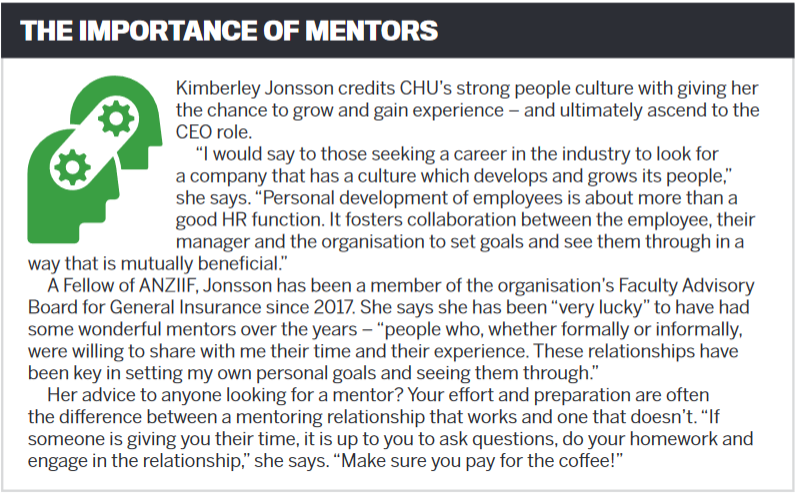

When Kimberly Jonsson applied for a job at strata specialist CHU 16 years ago – her first full-time employment after school – she never could have imagined that one day she’d be sitting in the CEO’s chair.
“To become CEO of the company where your career started is quite rare,” says Jonsson, who recently took over the reins of the under-writing agency from Bobby Lehane, who had served as CHU’s CEO since 2015.
Jonsson started her career in insurance after her first year at university – she’d worked casually at Target for five years, but when they stopped giving her hours, she needed to find a full-time job. She rose through CHU’s ranks, and by 2016 (at the age of 31), she was heading up a team of 20 as the organisation’s state manager for Queensland, a track record that netted her a spot on Insurance Business’ Young Guns list that year.
Jonsson distinguished herself as an effec-tive senior manager – GWP grew by 35% during her three years at the Queensland branch – and while she calls her appointment as CEO a “testament to the opportunities in the industry”, she says her journey hasn’t been without obstacles.
“It wasn’t until I started to work for Bobby that my age stopped being an issue in my career progression,” Jonsson says. “I’m one of the youngest CEOs in insurance, and I hope my appointment demonstrates what you can achieve in such a vibrant industry.”
As for the challenges, Jonsson sees them as having been necessary to her progression. “I can see with hindsight that those specific points in time were times of tremendous personal growth,” she says. “If I had given up – which any clever person likely would have – I wouldn’t have had the opportunities that came after.
“You can never stop learning, never stop growing. As the insurance industry continues to develop – and strata insurance is a very good example of this – to meet the changing demands of our customers, you can continue to simultaneously develop your skills and knowledge.”
Over 16 years, Jonsson has been witness to much change and innovation in the industry, with digitalisation at the fore-front. Four years ago, Lehane oversaw the introduction of CHUiSAVER, the sector’s first digital underwriting agency, which he said was designed to “pre-empt digital disruption”. Now trading as Flex Insurance, CHUiSAVER uses the internally developed StrataTech platform, a self-service policy and claims management system that enables brokers to transact business online, alongside CHU’s new internally developed rating engine and quoting application. The underwriting platform includes commercial strata, too.
“This is the first time brokers have been able to quote commercial strata online,” Jonsson says. “It’s been extremely popular since it was introduced.”
The demand for tailored, flexible insur-ance policies is growing, and the need to simplify the core strata insurance product is vital, she adds. Jonsson sees the shift toward brokers providing strata insurance contin-uing to accelerate.
“With the increasing complexity of schemes, strata insurance is – and will continue to be – an ideal avenue for brokers to demonstrate their professionalism and the power of personal advice to their clients,” she says.
As for Jonsson’s goals as CEO, she wants to build on Lehane’s legacy – to see through CHU’s “strong and dynamic” strategy for the next six years, the cornerstone of which is to build an even closer relationship with brokers and their clients.
“The increasing complexity of schemes and changing legislation requiring multiple quotes will continue to drive a shift to brokers for strata insurance,” Jonsson says. “CHU has moved to 80% broker distribution in recent years, which is a significant channel shift.”
Like other insurance customers, strata owners expect to have products that are tailored to their needs, so having the right technology to respond quickly and seamlessly is crucial, Jonsson says. “We want to take all of the effort out of dealing with CHU to make our service seamless, which will also enhance the service our broker partners can deliver to their clients.”
Open API allows connectivity with broker systems, and CHU is also working with optical character recognition (OCR) technology. “This will allow us to read remittances, claim forms and quote slips,” Jonsson explains.
“This will have the benefit internally of not needing to re-key data. Externally, it means brokers don’t need to change what they do at their end in order to benefit from our systems. For example, they can send their own slips to multiple insurers and receive a quote straight back from CHU.”
CHU has also developed a “What is Strata Insurance?” video to help the community understand this unique type of property ownership and the legislative requirements for insurance.
“Late last year, we translated this educa-tional video into Mandarin and have plans to create more in di erent languages in 2021,” Jonsson says. “We are constantly creating strata-related content for our intermedi-aries and strata owners to help demystify the insurance cover provided, identify common risks and how to avoid them.”

In addition to COVID-19, there are two ongoing issues hanging over the strata sector: building defects and dangerous clad-ding. Trust in apartment buildings has been decimated by high-profi le building defects cases. However, Jonsson hopes the establish-ment of the NSW Building Commission will shake up the building industry and provide confi dence for prospective buyers.
“The NSW construction watchdog now has the power to inspect building sites, prevent the issuing of occupation certifi-cates, call for documents and – an important feature – rectify serious defects and recovery of associated costs,” she says.
The dangers of cladding have been high-lighted by a few major disasters, including a February 2019 fire that raced up dangerous cladding on the side of the 41-storey Neo200 apartment building in Melbourne. This was the same sort of cladding involved in London’s Grenfell Tower tragedy.
The good news, Jonsson says, is that apartment owners forced to replace fl am-mable cladding on high-risk buildings across NSW will now be able to access interest-free loans as part of a $1bn government program over the next three years aimed at helping to resolve the crisis. The program includes $139m to o er technical support to owners for the remediation of at-risk buildings.
The NSW government’s move follows the Victorian government’s lead of funding rectification work. In July last year, Victoria announced a $600m package to directly cover owners’ costs to remove cladding from high-risk buildings.
The high-profile cases of dangerous cladding and other structural flaws have prompted some insurers to reduce their appe-tite for strata buildings – running the risk that, over time, some strata properties could become uninsurable. To address this, CHU has spent more time than ever working with brokers, strata managers and strata commit-tees to ensure major defects are addressed.
“When a building has an issue, the best form of mitigation from that building becoming uninsurable is a proactive strata committee,” Jonsson explains. “This means the biggest impact a broker can have on the insur-ability of a building is to educate committees on their risks and how building maintenance can impact insurance availability and pricing.”
Creating a company that is flexible and dynamic enough to tackle the needs of the ever-evolving strata market starts with hiring the right people. In this regard, Jonsson credits her predecessor with prioritising diver-sity and inclusion as a major plank of CHU’s strategy. This led to the company winning ANZIIF’s inaugural Excellence in Workplace Diversity and Inclusion Award in 2019.
Jonsson sees diversity and inclusion as key to providing a larger spectrum of knowledge, values and preferences – not to mention benefi ting a company’s ability to innovate, improve its customer focus and promote employee morale. Plus, a diverse range of skills can o er an advantage to a company like CHU that caters to a multi-cultural, multi-generational customer demographic.
A decade and a half after fi rst setting foot in CHU’s o ces, Jonsson fi nds herself at the helm of an organisation that is working hard to dismantle barriers – including the ones she herself faced. CHU’s leadership team has an equal gender split, with ages spanning from 20s through to 60s, and women repre-sent 55% of all leaders at the company.
“While diversity has always been part of CHU’s DNA and contributed to our success, in recent years, we made the decision to focus on it as a strategic imperative,” Jonsson says. “It’s absolutely critical to our strategic success over the next fi ve to 10 years.”
